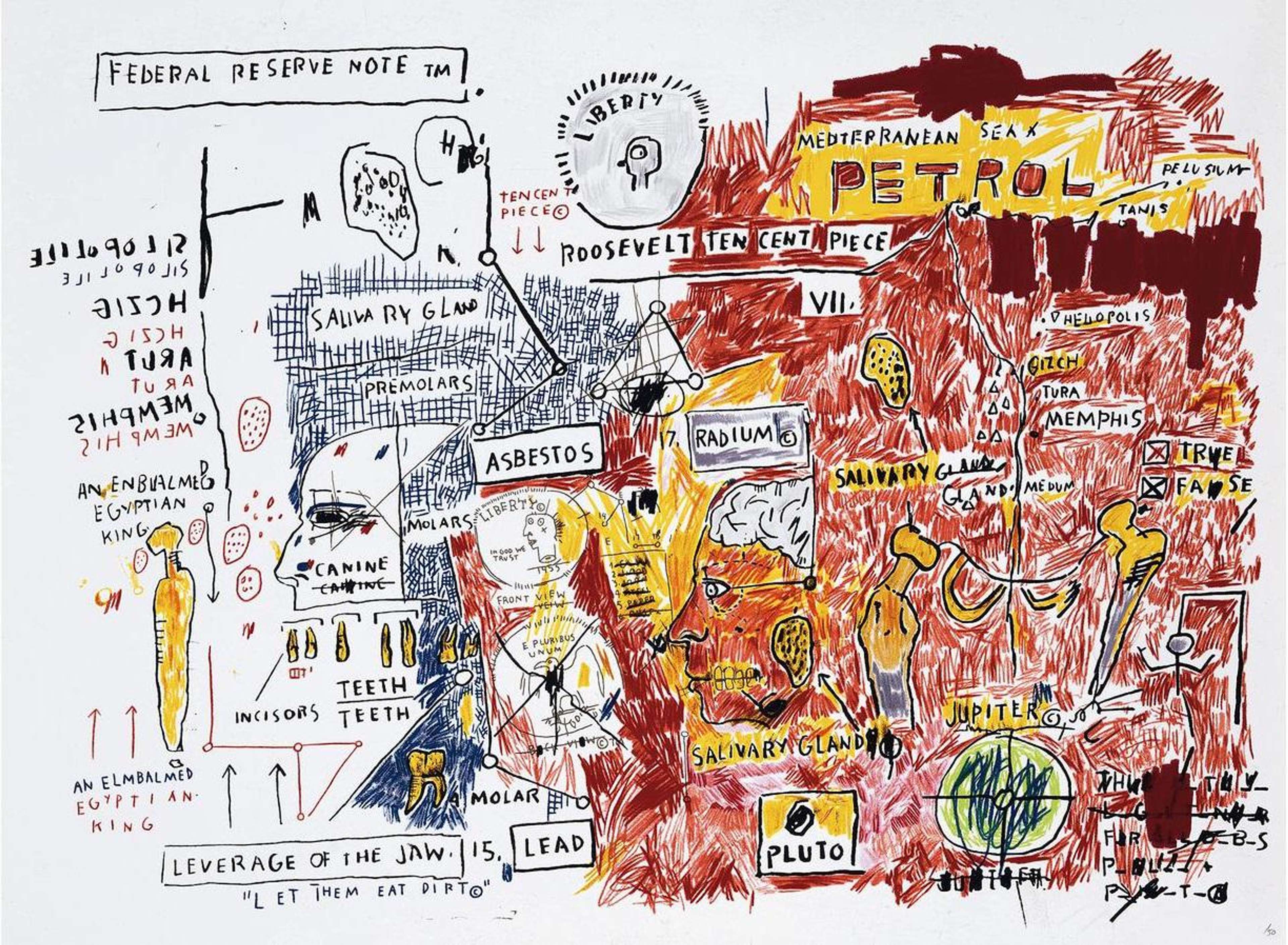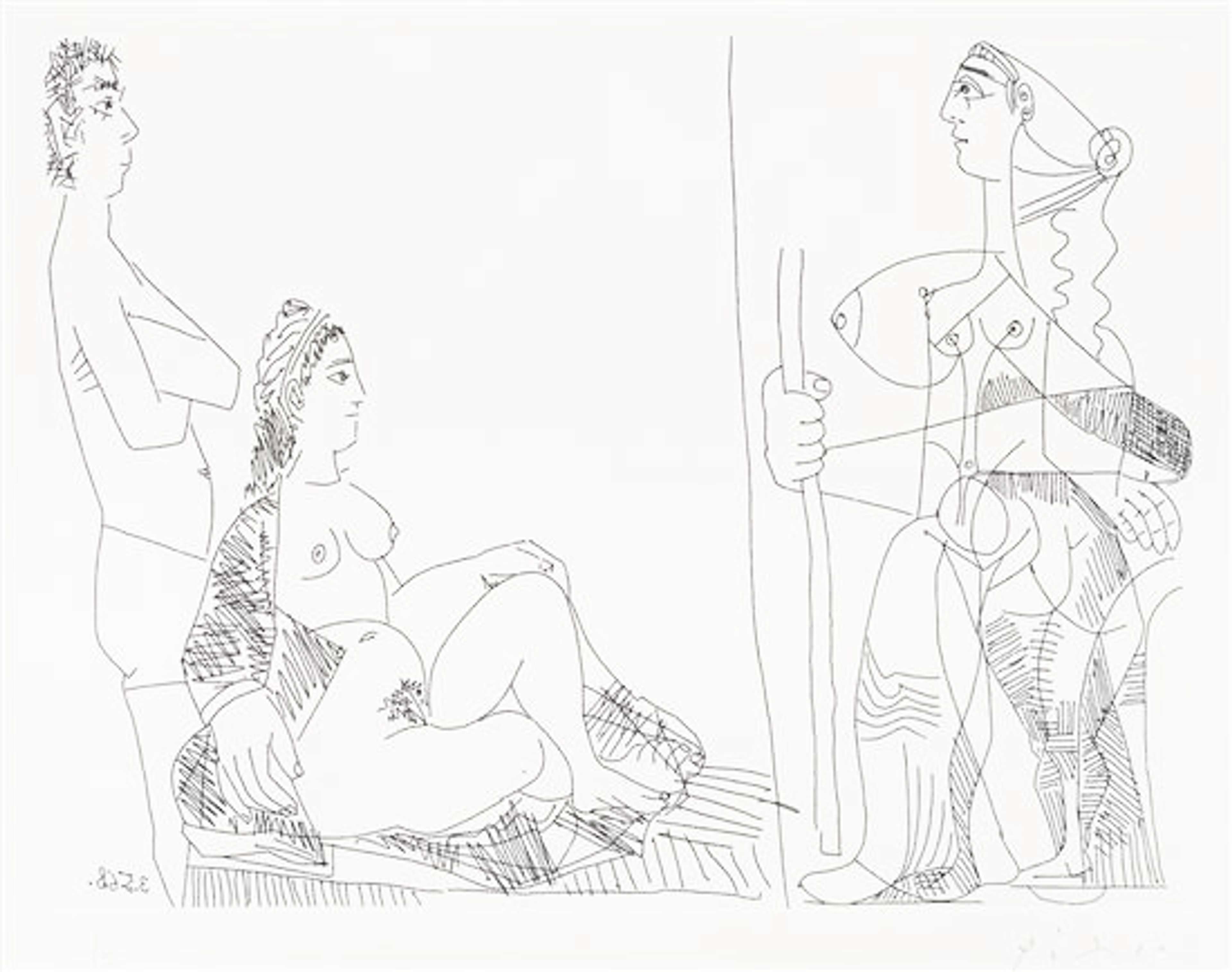Young and Old Picasso: The Spanish Artist’s Influence on Jean-Michel Basquiat

 Image © Christie’s / Untitled (Picasso) © Jean-Michel Basquiat 1984
Image © Christie’s / Untitled (Picasso) © Jean-Michel Basquiat 1984
Pablo Picasso
160 works
Artistic influences can often transcend time, creating bridges between generations and styles. Such is the case between two titans of the art world: Pablo Picasso, the prolific Spanish master, and Jean-Michel Basquiat, an innovative and groundbreaking American artist of the late 20th century. Picasso was one of Basquiat’s greatest artistic heroes, with the latter claiming that seeing Guernica at the MoMA during his childhood was a formative experience.
The influence the Spanish master had on the American Neo-Expressionist serves as an intriguing study into how the creativity and ingenuity of one artist can deeply inspire and shape the work of another, even years after the original artist’s lifetime and despite seemingly disparate life experiences. Nowhere else is this more evident than in Basquiat’s remarkable portraits of Picasso, one of which just recently sold at Christie’s for £6,462,500.
Rebels in Art: Picasso and Basquiat's Rebellion Against Traditional Fine Art Conventions
Pablo Picasso, born in 1881, holds an unrivalled position in the annals of 20th century art. His revolutionary spirit and multifaceted talent ushered in transformative movements like Cubism and Surrealism, critically impacting the future of the artistic world. Picasso's exploratory journeys through his Blue, Rose, African art-inspired and Cubist periods, among others, bore testament to his ceaseless thirst for innovation. His works questioned established norms, redefining the contours of artistic expression. Similarly transformative, Jean-Michel Basquiat emerged from the graffiti-splattered streets of Brooklyn in the late 70s and early 80s. Of Haitian-Puerto Rican descent, Basquiat carved a niche for himself in the domain of Neo-Expressionist art. His works offered raw, unfiltered perspectives on themes ranging from wealth and poverty to integration and segregation, and the nuances of inner versus outer experience.
Both artists shared a deep desire to challenge the prevalent norms of the art world. Their work, separated by decades, represents a shared instinct to rebel against the traditional and to question the established conventions of their times. Through his development of Cubism, Picasso deconstructed familiar forms, presenting multiple viewpoints simultaneously and shattering the tradition of perspective that had governed Western art since the Renaissance. This avant-garde movement was nothing short of a seismic shift, reshaping the landscape of European art. Picasso's later exploration into Surrealism and Symbolism further highlighted his willingness to break with tradition and chart his own course. He was also an outspoken critic of Franco’s brutal regime, producing subversive art that aligns with Basquiat’s own approach to politically-charged art.
In his time, Basquiat also emerged as a nonconformist, dismissing the polished, elite world of art galleries in favour of graffiti-laden city walls and a spontaneous method of painting. His transition from anonymous graffiti artist to Neo-Expressionist star did little to curb his rebellious nature. His artwork often incorporated words, symbols and crude figures, a remnant of his street art beginnings. Basquiat's bold colours, intense imagery and scribble-like style disregarded conventional fine art techniques, instead offering raw commentary on class struggle, colonialism and racism.
Both Picasso and Basquiat, as rebels in their own right, carved out spaces for themselves in the history of art. Their rebellion against the status quo and their shared commitment to their own style, irrespective of the norms of the art world, not only set them apart in their own times but continues to influence artists today. Their criticism of established political structures also binds them, further solidifying the artist’s role in providing social commentary.
Shared Inspirations: Picasso and Basquiat's Fascination with African Art
Stylistically, both artists displayed a tendency towards figurative abstraction, a common fascination with symbolism, and an innovative use of text in their art. In terms of motifs, one of the most compelling ties between Picasso and Basquiat lies in their shared affinity for African art. Both artists found in African artistic traditions a deep well of inspiration that would leave a lasting imprint on their work.
Picasso's interest in African art was sparked in the early 20th century during his "African Period", which spanned from 1906 to 1909 and reflected a general interest in the continent by the decade’s intellectuals. Exposed to tribal art forms in a museum in Paris, Picasso was moved by the power, symbolic forms and the spiritual quality of these works. He was also especially impressed by the way that faces were depicted in sculptures and masks. This led to a marked transformation in his style, one that moved away from traditional Western art forms and embraced more geometric depictions. The African influence on Picasso's work was significant in the advent of Cubism, and Picasso's iconic painting Les Demoiselles d'Avignon – often cited as one of the first Cubist pieces – prominently features mask-like faces inspired by African sculptures.
Several decades later, Basquiat reflected a profound influence of African art in his work, largely inspired by his own cultural heritage. As a child, Basquiat was introduced to a wide range of artistic styles and cultures but was particularly drawn to African motifs, which later became a recurring theme in his artwork. Basquiat’s use of mask and skull imagery, bold colour palettes and fragmented bodies echo the visual vocabularies found in African art. Moreover, his thematic exploration of power, oppression, racism and heritage resonates with the socio-cultural narratives often embedded in African artistic tradition.
For both Picasso and Basquiat, the incorporation of African art elements into their work signified more than stylistic experimentation – it was an assertion of their independence from traditional Western art conventions.
Narrative and Emotion in Art: How Picasso and Basquiat Communicated Complex Themes
Both Picasso and Basquiat used their art as a medium for communicating complex themes and evoking intense emotions, possessing the uncanny ability to imbue their works with narratives that were deeply personal yet reflective of broader societal issues in their time. As an artist during the Spanish Civil War era, Picasso frequently explored themes of war, peace and suffering in his works. His most famous piece Guernica is a powerful depiction of the bombing of the Spanish town of Guernica during the Civil War. Its monochromatic palette, fractured forms and the anguished expressions of the figures combine to create a deeply moving narrative about the horrors of combat. Throughout his different periods, Picasso's art was always infused with feeling, often reflecting his personal experiences and moods. He was a master in depicting facial expressions and using colours to amplify moods, using these to convey a wide range of deep emotions.
Like Picasso, Basquiat was also deeply connected to the world around him, with his artwork often serving as a commentary on the society he lived in. His paintings frequently addressed themes of race, class and history, drawn from his own experiences as a person of colour in the United States during the 1980s. Works like Irony of a Negro Policeman reveal Basquiat's critical commentary on power structures and racial identity, and Basquiat's raw and energetic style – filled with intense colour and chaotic lines – served as an emotional barometer, often reflecting his inner turmoil and struggles with addiction and fame.
In both Picasso's and Basquiat's works, there is an intense exploration of narrative and emotion. Their ability to communicate complex themes and evoke emotional responses is a testament to their prowess as artists. Their works served as a mirror to the society they lived in, providing commentary and insight into the human condition.
 Image © Christie’s / Young Picasso © Jean-Michel Basquiat 1984
Image © Christie’s / Young Picasso © Jean-Michel Basquiat 1984Picasso's Direct Impact: Examining Picasso's Influence in Basquiat's Art
The influence of Picasso on Basquiat is perhaps most directly visible in the explicit tribute paid by Basquiat in his paintings, particularly Untitled (Pablo Picasso) (1984) and Young Picasso (1984). Untitled (Pablo Picasso), a striking acrylic and oilstick work, sold for £6,462,500 in June 2023 at Christie’s in London, underscoring its significance in Basquiat’s oeuvre. In these works, Basquiat’s depiction of Picasso is both powerful and poignant: his face is rendered almost as a mask, drawing a clear parallel to their mutual fascination with African art. The use of vibrant primary colours pays homage to Picasso’s bold hues from his Rose and later periods. The results are striking, with Basquiat constructing the Spanish master’s portraits in his own inimitable style while also referencing Picasso's visual language. These paintings stand as a visible homage to Picasso, firmly situating the Spanish master’s influence within Basquiat’s body of work.
In Untitled (1984), Picasso is depicted with the breton shirt he would become synonymous with in his later years, although the label “Picasso at 15 Years Old” can be seen in between the stripes. His hair is blue, a playful reference to the period so associated with the artist, and a blue cloud floats over the artist’s head. It is a playful reflection on the semi-mythical status achieved by the artist, without denying his impact on Basquiat himself. In Young Picasso (1984), Basquiat presents two striking side-by-side portraits of Picasso – one youthful, the other aged. The depiction of 'Young Picasso' is intricately detailed in an ochre hue, capturing a sense of youthful vigour and observation. Contrastingly, the 'Old Picasso' is rendered in red, his features deliberately obscured with scribbles, suggesting the passage of time and the transformative journey of the artist's life. It can also be seen as a commentary with the art world’s obsession with prodigious youth, one that Basquiat understood all too well.
The fusion of Picasso's pioneering aesthetics with Basquiat's groundbreaking style produced work that was uniquely Basquiat, yet distinctly Picasso-esque. This ability to take inspiration while also making the work distinctly his own is a testament to Basquiat's unique talent and artistic vision. Overall, these Picasso-centric pieces by Basquiat underscore Picasso's enduring relevance and the profound impact he had on subsequent generations of artists.
Legacy and Influence: The Picasso x Basquiat Works on the Market
The art world is replete with stories of influences and inspirations that weave together artists from different periods, backgrounds and styles. The legacy of Picasso's influence on Basquiat is a compelling example of this phenomenon and offers rich insight into the interconnected tapestry of art history. When considering the artworks where Basquiat directly referenced Picasso, a vibrant discourse between two transformative artists exists, highlighting how artistic influence can resonate across generations.
These works showed how the inspiration derived from a historic figure like Picasso could be integrated and reinterpreted in a contemporary context, creating a dynamic dialogue between past and present, between tradition and innovation, adding a layer of depth to Basquiat's work and extending the reach of Picasso's influence into the late 20th century. The recognition of these Picasso x Basquiat pieces, as evidenced by the Christie’s sale, also reveals the broader art world's fascination with the transfer and transformation of artistic legacy. They serve as tangible evidence of how one artist can reshape and reinterpret the work of another, carrying forward their influence in novel and exciting directions.
In the end, the Picasso x Basquiat works not only represent a personal homage from one artist to another, but they also encapsulate the fluidity, complexity and enduring fascination of the art world with influence and legacy. The connection between these two artists stands as a testament to an artistic torch passed from Picasso to Basquiat – a shared ambition to disrupt, innovate and perpetually redefine the landscape of art.










